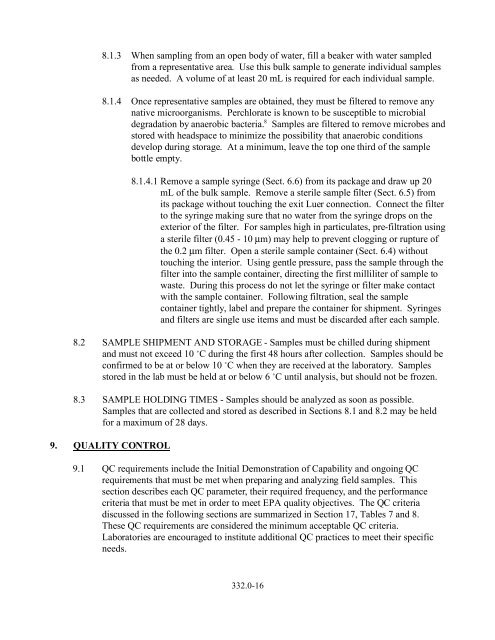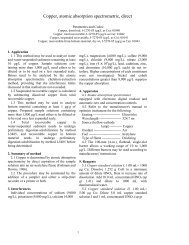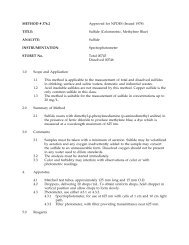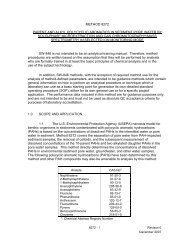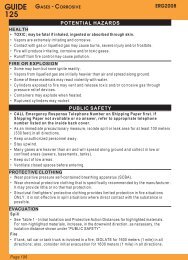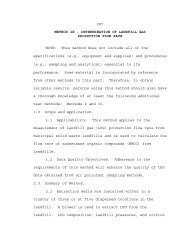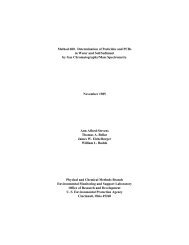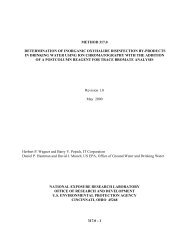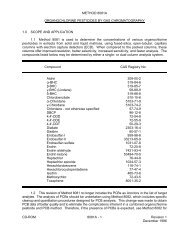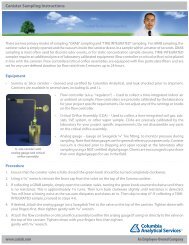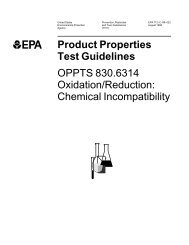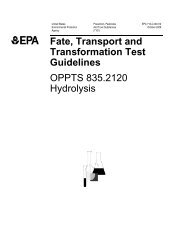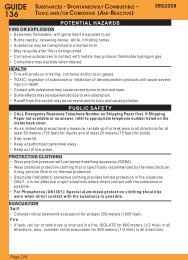View Actual EPA Method 332 (PDF File) - Columbia Analytical ...
View Actual EPA Method 332 (PDF File) - Columbia Analytical ...
View Actual EPA Method 332 (PDF File) - Columbia Analytical ...
You also want an ePaper? Increase the reach of your titles
YUMPU automatically turns print PDFs into web optimized ePapers that Google loves.
8.1.3 When sampling from an open body of water, fill a beaker with water sampled<br />
from a representative area. Use this bulk sample to generate individual samples<br />
as needed. A volume of at least 20 mL is required for each individual sample.<br />
8.1.4 Once representative samples are obtained, they must be filtered to remove any<br />
native microorganisms. Perchlorate is known to be susceptible to microbial<br />
degradation by anaerobic bacteria. 8 Samples are filtered to remove microbes and<br />
stored with headspace to minimize the possibility that anaerobic conditions<br />
develop during storage. At a minimum, leave the top one third of the sample<br />
bottle empty.<br />
8.1.4.1 Remove a sample syringe (Sect. 6.6) from its package and draw up 20<br />
mL of the bulk sample. Remove a sterile sample filter (Sect. 6.5) from<br />
its package without touching the exit Luer connection. Connect the filter<br />
to the syringe making sure that no water from the syringe drops on the<br />
exterior of the filter. For samples high in particulates, pre-filtration using<br />
a sterile filter (0.45 - 10 µm) may help to prevent clogging or rupture of<br />
the 0.2 µm filter. Open a sterile sample container (Sect. 6.4) without<br />
touching the interior. Using gentle pressure, pass the sample through the<br />
filter into the sample container, directing the first milliliter of sample to<br />
waste. During this process do not let the syringe or filter make contact<br />
with the sample container. Following filtration, seal the sample<br />
container tightly, label and prepare the container for shipment. Syringes<br />
and filters are single use items and must be discarded after each sample.<br />
8.2 SAMPLE SHIPMENT AND STORAGE - Samples must be chilled during shipment<br />
and must not exceed 10 C during the first 48 hours after collection. Samples should be<br />
confirmed to be at or below 10 C when they are received at the laboratory. Samples<br />
stored in the lab must be held at or below 6 C until analysis, but should not be frozen.<br />
8.3 SAMPLE HOLDING TIMES - Samples should be analyzed as soon as possible.<br />
Samples that are collected and stored as described in Sections 8.1 and 8.2 may be held<br />
for a maximum of 28 days.<br />
9. QUALITY CONTROL<br />
9.1 QC requirements include the Initial Demonstration of Capability and ongoing QC<br />
requirements that must be met when preparing and analyzing field samples. This<br />
section describes each QC parameter, their required frequency, and the performance<br />
criteria that must be met in order to meet <strong>EPA</strong> quality objectives. The QC criteria<br />
discussed in the following sections are summarized in Section 17, Tables 7 and 8.<br />
These QC requirements are considered the minimum acceptable QC criteria.<br />
Laboratories are encouraged to institute additional QC practices to meet their specific<br />
needs.<br />
<strong>332</strong>.0-16


